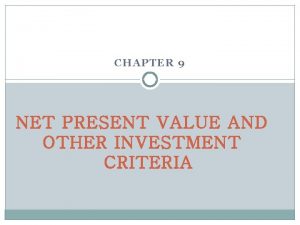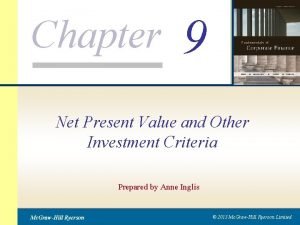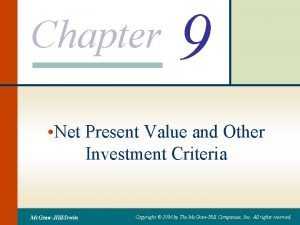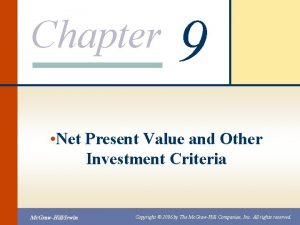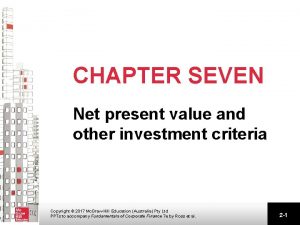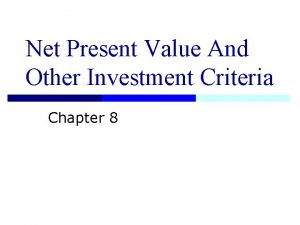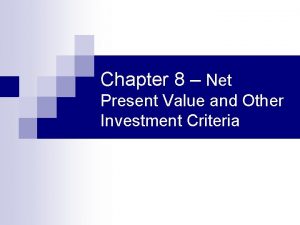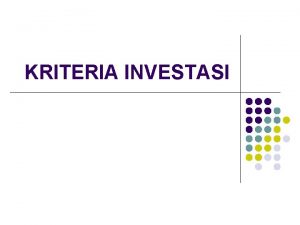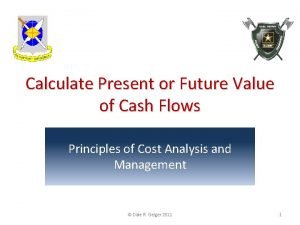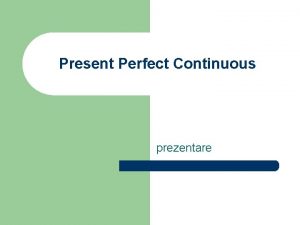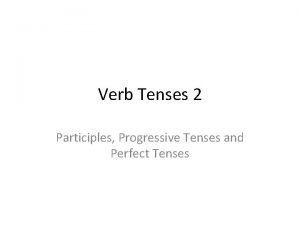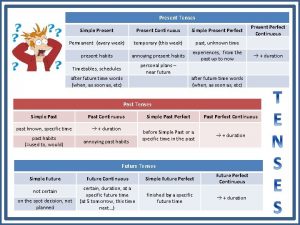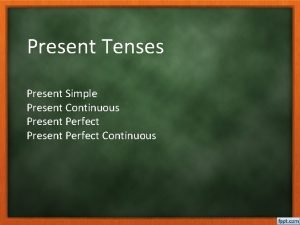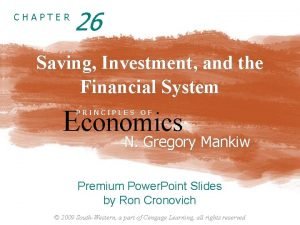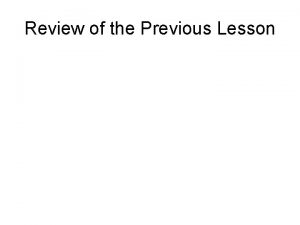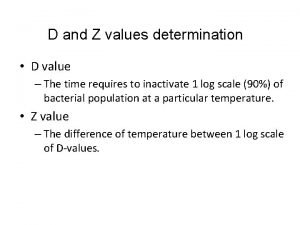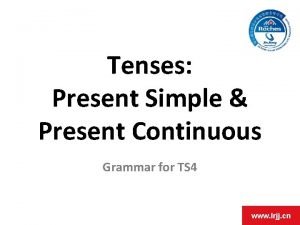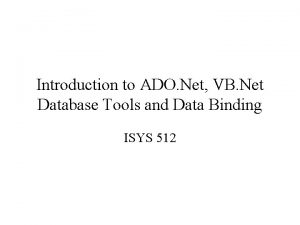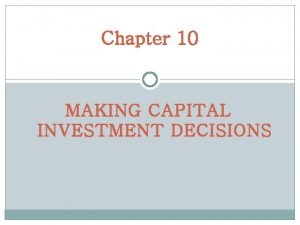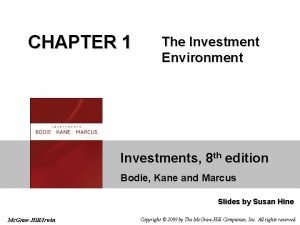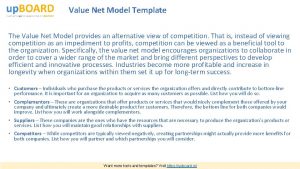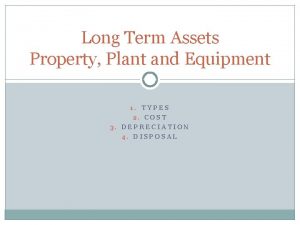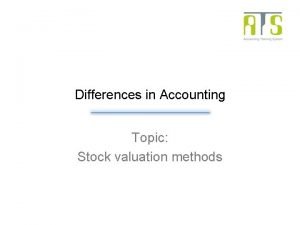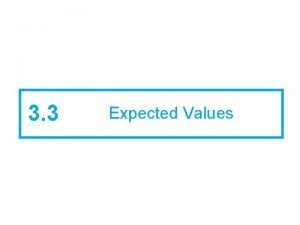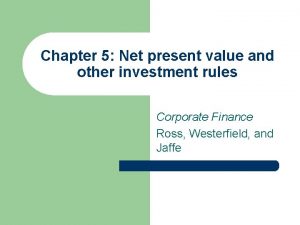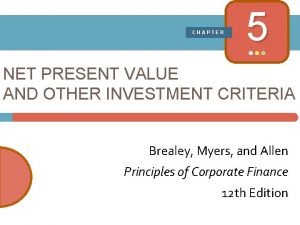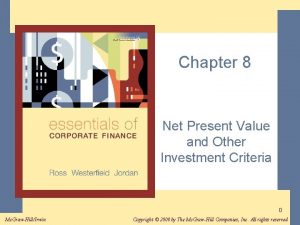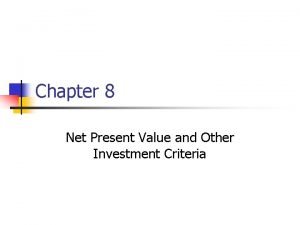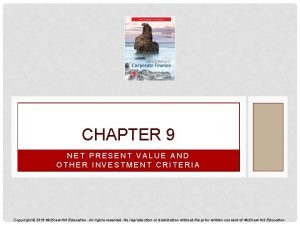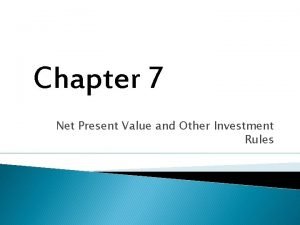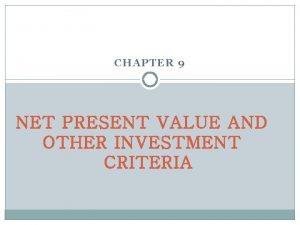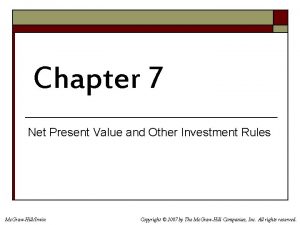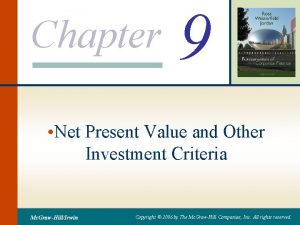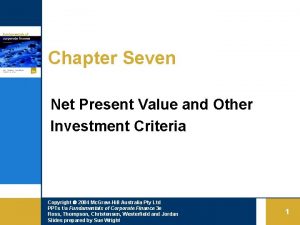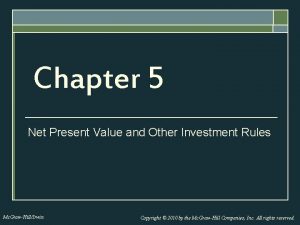Chapter 9 Net Present Value and Other Investment





















































- Slides: 53

Chapter 9 • Net Present Value and Other Investment Criteria Mc. Graw-Hill/Irwin Copyright © 2006 by The Mc. Graw-Hill Companies, Inc. All rights reserved.

Key Concepts and Skills • Be able to compute payback and discounted payback and understand their shortcomings • Understand accounting rates of return and their shortcomings • Be able to compute the internal rate of return and understand its strengths and weaknesses • Be able to compute the net present value and understand why it is the best decision criterion 1

What is capital budgeting? • Process of planning and evaluating expenditures on asset whose cash flows are beyond 1 year. • Decide which are acceptable investments • Decide which actually should be purchased (or invested) • Long-term decisions; involve large expenditures. • Very important to firm’s future. 2

Good Decision Criteria • We need to ask ourselves the following questions when evaluating capital budgeting decision rules • Does the decision rule adjust for the time value of money? • Does the decision rule adjust for risk? • Does the decision rule provide information on whether we are creating value for the firm? 3

Main criteria • • • The Payback The Discounted Payback Net Present Value The Internal Rate of Return The Profitability Index The Average Accounting Return 4

What is the payback period? The number of years required to recover a project’s cost, or how long does it take to get the business’s money back? 5

Payback for Franchise L (Long: Most CFs in out years) 0 1 CFt -100 Cumulative -100 Payback. L = 2 2 10 -90 + 30/80 2. 4 60 100 -30 0 3 80 50 = 2. 375 years 6

Franchise S (Short: CFs come quickly) 0 CFt -100 Cumulative -100 Payback. S 1. 6 2 3 70 100 50 20 -30 40 1 0 20 = 1 + 30/50 = 1. 6 years 7

Payback Period • Computation • Estimate the cash flows • Subtract the future cash flows from the initial cost until the initial investment has been recovered • Decision Rule – Accept if the payback period is less than some preset limit • If the cut-off point is 2 years, which project should be accepted, which should be rejected? 8

Strengths and weaknesses of payback • Strengths • Provides an indication of a project’s risk and liquidity. • Easy to calculate and understand. • Weaknesses • Ignores the time value of money. • Ignores CFs occurring after the payback period. • requires an arbitrary cut-off point 9

Discounted Payback Period • Compute the present value of each cash flow and then determine how long it takes to payback on a discounted basis • Compare to a specified required period • Decision Rule - Accept the project if it pays back on a discounted basis within the specified time 10

Discounted Payback: Uses discounted rather than raw CFs. Project L 0 10% 1 2 3 10 60 80 CFt -100 PVCFt -100 9. 09 49. 59 60. 11 Cumulative -100 -90. 91 -41. 32 18. 79 Discounted = 2 payback + 41. 32/60. 11 = 2. 7 yrs Recover invest. + cap. costs in 2. 7 yrs. 11

Discounted payback period (project S) • Uses discounted cash flows rather than raw CFs. 0 CFt PV of CFt Cumulative 10% -100 Disc Payback. S == 2 1 70 63. 64 -36. 36 + 2 50 41. 32 4. 96 36. 36 / 41. 32 3 20 15. 03 19. 99 = 1. 88 years 12

Advantages and Disadvantages of Discounted Payback • Advantages • Includes time value of money • Easy to understand • Disadvantages • Requires an arbitrary cutoff point • Ignores cash flows beyond the cutoff point 13

Net Present Value • The difference between the market value of a project and its cost • How much value is created from undertaking an investment? • The first step is to estimate the expected future cash flows. • The second step is to estimate the required return for projects of this risk level. • The third step is to find the present value of the cash flows and subtract the initial investment. 14

NPV: Sum of the PVs of inflows and outflows. Cost often is CF 0 and is negative. 15

NPV – Decision Rule • If the NPV is positive, accept the project • A positive NPV means that the project is expected to add value to the firm and will therefore increase the wealth of the owners. • Since our goal is to increase owner wealth, NPV is a direct measure of how well this project will meet our goal. 16

What’s Franchise L’s NPV? Project L: 0 -100. 00 10% 1 2 3 10 60 80 9. 09 49. 59 60. 11 18. 79 = NPVL 17

Calculator Solution Enter in CFLO for L: -100 CF 0 10 CF 1 60 CF 2 80 CF 3 10 I NPV = 18. 78 = NPVL 18

What’s Franchise S’s NPV? Project S: 0 10% -100. 00 1 2 3 70 50 20 63. 64 41. 32 15. 03 19. 98 = NPVS 19

Calculator Solution Enter in CFLO for S: -100 CF 0 70 CF 1 50 CF 2 20 CF 3 10 I NPV = 19. 98 = NPVS 20

Decision Criteria Test - NPV • Does the NPV rule account for the time value of money? • Does the NPV rule account for the risk of the cash flows? • Does the NPV rule provide an indication about the increase in value? • Should we consider the NPV rule for our primary decision rule? 21

Internal Rate of Return • This is the most important alternative to NPV • It is often used in practice and is intuitively appealing • It is based entirely on the estimated cash flows and is independent of interest rates found elsewhere • Project A: cost $1000, PV of all future cash flows = $1500. What is NPV of A? • Project B: cost $1, 000, PV of all future cash flows = $1, 500, 000. What is NPV of B? • We might need a rate of return in this case. 22

Internal Rate of Return: IRR 0 1 2 3 CF 0 Cost CF 1 CF 2 Inflows CF 3 IRR is the discount rate that forces PV inflows = cost. This is the same as forcing NPV = 0. 23

NPV: Enter r, solve for NPV. IRR: Enter NPV = 0, solve for IRR. 24

What’s Franchise L’s IRR? 0 IRR = ? -100. 00 PV 1 PV 2 PV 3 0 = NPV 1 2 3 10 60 80 Enter CFs in CFLO, then press IRR: IRRL = 18. 13%. IRRS = 23. 56%. 25

Rationale for the IRR Method If IRR > cost of capital (or required return), then the project’s rate of return is greater than its cost-- some return is left over to boost stockholders’ returns. Example: required return = 10%, IRR = 15%. Profitable. If required return = 10%, should we accept or reject L and S? 26

Decision Criteria Test - IRR • Does the IRR rule account for the time value of money? • Does the IRR rule account for the risk of the cash flows? • Does the IRR rule provide an indication about the increase in value? • Should we consider the IRR rule for our primary decision criteria? 27

Advantages of IRR • Knowing a return is intuitively appealing • It is a simple way to communicate the value of a project to someone who doesn’t know all the estimation details • If the IRR is high enough, you may not need to estimate a required return, which is often a difficult task 28

NPV Vs. IRR • NPV and IRR will generally give us the same decision • Exceptions • Non-conventional cash flows – cash flow signs change more than once • Mutually exclusive projects • Initial investments are substantially different • Timing of cash flows is substantially different 29

NPV Vs. IRR • NPV and IRR will generally give us the same decision • NPV>0 and IRR> required return • NPV<0 and IRR< required return • NPV=0 and IRR= required return 30

Project Example Information • You are looking at a new project and you have estimated the following cash flows: • • Year 0: Year 1: Year 2: Year 3: CF = -165, 000 CF = 63, 120; CF = 70, 800; CF = 91, 080; 31

NPV profile • A graphical representation of the relationship between an investment’s NPV and various discount rates (required return) • IRR = 16. 13324% • R = 0, NPV = 60, 000 • R = 10, NPV = 19, 324 • R = 16. 3224, NPV = 0 • R = 18, NPV = -5227 • IRR > R, NPV > 0 • IRR < R, NPV < 0 • Same decision 32

NPV Profile For The Project IRR = 16. 13% 33

NPV Vs. IRR • NPV and IRR will generally give us the same decision • Exceptions • Non-conventional cash flows – cash flow signs change more than once • Mutually exclusive projects • Initial investments are substantially different • Timing of cash flows is substantially different 34

NPV Vs. IRR • Non-conventional cash flows – cash flow signs change more than once • Normal (conventional) Time 0 1 2 3 CF -300 150 200 250 sign + + + • Non-normal (non-conventional) Time 0 1 2 3 CF -90, 000 132, 000 100, 000 -150, 000 sign + + • More than 1 IRR, if the signs change 2 times, we have 2 IRRs, the signs changes 3 times, we have 3 IRRs 35

IRR and Non-conventional Cash Flows • When the cash flows change sign more than once, there is more than one IRR • When you solve for IRR you are solving for the root of an equation and when you cross the x-axis more than once, there will be more than one return that solves the equation • If you have more than one IRR, which one do you use to make your decision? 36

Example – Non-conventional Cash Flows • Suppose an investment will cost $90, 000 initially and will generate the following cash flows: • Year 1: 132, 000 • Year 2: 100, 000 • Year 3: -150, 000 • The required return is 15%. • Should we accept or reject the project? 37

Example – Non-conventional Cash Flows • Calculator: CF 0 = -90, 000; C 01 = 132, 000; F 01 = 1; C 02 = 100, 000; F 02 = 1; C 03 = -150, 000; F 03 = 1; I = 15; CPT NPV = 1769. 54 • Solve for IRR • 0 = -90, 000 + 132, 000/(1+IRR)1 +100, 000/(1+IRR)2 -150, 000/(1+IRR)3 • (IRR-0. 101102)(IRR-0. 426585) = 0 • IRR = 10. 1102% and IRR = 42. 6585% • If you compute the IRR on the calculator, you get 10. 1102% because it is the first one that you come to. 38

Summary of Decision Rules • The NPV is positive at a required return of 15%, so you should Accept • If you use the financial calculator, you would get an IRR of 10. 11% which would tell you to Reject • You need to recognize that there are nonconventional cash flows and look at the NPV profile • When you have conflict between NPV and IRR, go with the NPV 39

NPV Profile IRR = 10. 11% and 42. 66% 40

IRR and Mutually Exclusive Projects • Independent and Mutually exclusive projects • Independent: the decision to accept/reject one project does not affect the decision to accept/reject another. • Mutually exclusive: If you choose one, you can’t choose the other • NPV(L) = 18. 79, NPV(S) = 19. 98 • If L and S are independent, which project should we accept? • IF L and S are mutually exclusive, which project should we accept? • Intuitively you would use the following decision rules (if mutually exclusive) • NPV – choose the project with the higher NPV • IRR – choose the project with the higher IRR 41

Example With Mutually Exclusive Projects Period Project A Project B 0 -500 -400 1 325 200 IRR 19. 43% 22. 17% NPV 64. 05 The required return for both projects is 10%. Which project should you accept and why? 60. 74 42

Period A B A-B 0 -500 -400 -100 1 325 0 2 325 200 125 • Cross-over rate is the rate where NPV(A) = NPV(B). It is the IRR of the difference in the cash flows of the 2 projects • IRR (A-B) = cross over rate = 11. 8034% 43

NPV Profiles IRR for A = 19. 43% IRR for B = 22. 17% Crossover Point = 11. 8% 44

Example With Mutually Exclusive Projects Period Project A Project B 0 -500 -400 1 325 200 IRR 19. 43% 22. 17% NPV 64. 05 The required return for both projects is 10%. Which project should you accept and why? 60. 74 45

Conflicts Between NPV and IRR • NPV directly measures the increase in value to the firm • Whenever there is a conflict between NPV and another decision rule, you should always use NPV • IRR is unreliable in the following situations • Non-conventional cash flows • Mutually exclusive projects 46

Profitability Index • PI = PV of future cash flows/ Intial cost • Measures the benefit per unit cost, based on the time value of money • A profitability index of 1. 1 implies that for every $1 of investment, we create an additional $0. 10 in value • Can have conflict with NPV in some mutually exclusive projects • This measure can be very useful in situations in which we have limited capital 47

Advantages and Disadvantages of Profitability Index • Advantages • Closely related to NPV, generally leading to identical decisions • Easy to understand communicate • May be useful when available investment funds are limited • Disadvantages • May lead to incorrect decisions in comparisons of mutually exclusive investments 48

Summary – Discounted Cash Flow Criteria • Net present value • • Difference between market value and cost Take the project if the NPV is positive Has no serious problems Preferred decision criterion • Internal rate of return • • Discount rate that makes NPV = 0 Take the project if the IRR is greater than the required return Same decision as NPV with conventional cash flows IRR is unreliable with non-conventional cash flows or mutually exclusive projects • Profitability Index • • Benefit-cost ratio Take investment if PI > 1 Cannot be used to rank mutually exclusive projects May be used to rank projects in the presence of capital rationing 49

Summary – Payback Criteria • Payback period • Length of time until initial investment is recovered • Take the project if it pays back in some specified period • Doesn’t account for time value of money and there is an arbitrary cutoff period • Discounted payback period • Length of time until initial investment is recovered on a discounted basis • Take the project if it pays back in some specified period • There is an arbitrary cutoff period 50

Capital Budgeting In Practice • If NPV is superior than all other method, why should we consider IRR, payback, etc? • Convenience • NPV is only an estimate, it depends on future cash flows and discount rate. Both are estimates. Therefore, we need to compute other criteria to strengthen our decisions • In theory, NPV is the best • In practice, NPV: 74. 9%, IRR: 75. 7%, and payback 56. 7%. Small companies use payback, big companies use IRR, NPV 51

Capital Budgeting In Practice • We should consider several investment criteria when making decisions • NPV and IRR are the most commonly used primary investment criteria • Payback is a commonly used secondary investment criteria 52
 Chapter 9 net present value and other investment criteria
Chapter 9 net present value and other investment criteria Chapter 9 net present value and other investment criteria
Chapter 9 net present value and other investment criteria Advantage and disadvantage of npv
Advantage and disadvantage of npv Chapter 9 net present value and other investment criteria
Chapter 9 net present value and other investment criteria Net present value of investment
Net present value of investment Fixed investment and inventory investment
Fixed investment and inventory investment Contoh value creation adalah
Contoh value creation adalah What is the formula for profitability index
What is the formula for profitability index Npv
Npv Payback chapter 8
Payback chapter 8 Net present value practice problems
Net present value practice problems Net present value assumptions
Net present value assumptions Net present value
Net present value Kriteria npv
Kriteria npv Future value of $1
Future value of $1 Present simple present continuous and present perfect
Present simple present continuous and present perfect Value line investment survey
Value line investment survey Types of position
Types of position Present perfect present simple present continuous
Present perfect present simple present continuous Present perfect continuous affirmative
Present perfect continuous affirmative Present perfect simple schema
Present perfect simple schema Relative clause noredink
Relative clause noredink Wish in present
Wish in present Present simple present continuous present perfect
Present simple present continuous present perfect Chapter 6 theories of international trade and investment
Chapter 6 theories of international trade and investment Mankiw chapter 26 solutions
Mankiw chapter 26 solutions Valrox
Valrox How to calculate fold change
How to calculate fold change D value and z value
D value and z value Ester value principle
Ester value principle Capturing value from customers
Capturing value from customers Present simple tense
Present simple tense Achmed lach net ich krieg mein tach net
Achmed lach net ich krieg mein tach net Ado.net vb.net
Ado.net vb.net Chapter 1 the investment environment
Chapter 1 the investment environment Kieso chapter 17
Kieso chapter 17 Cca tax shield formula
Cca tax shield formula Chapter 8 foreign direct investment
Chapter 8 foreign direct investment Nwc change
Nwc change Chapter 1 the investment environment
Chapter 1 the investment environment The value net model
The value net model Specific identification method
Specific identification method Net book value
Net book value Retail inventory method formula
Retail inventory method formula Ias 2 net realisable value
Ias 2 net realisable value Relative value vs absolute value
Relative value vs absolute value How to find expected value of a spinner
How to find expected value of a spinner How to find expected values
How to find expected values Examples of anthropocentrism
Examples of anthropocentrism Present and future value of money
Present and future value of money Undelies
Undelies Interlanguage and social identity and investment
Interlanguage and social identity and investment Inhibitions drivers ed
Inhibitions drivers ed Chapter 31 schizophrenia and other psychoses
Chapter 31 schizophrenia and other psychoses
